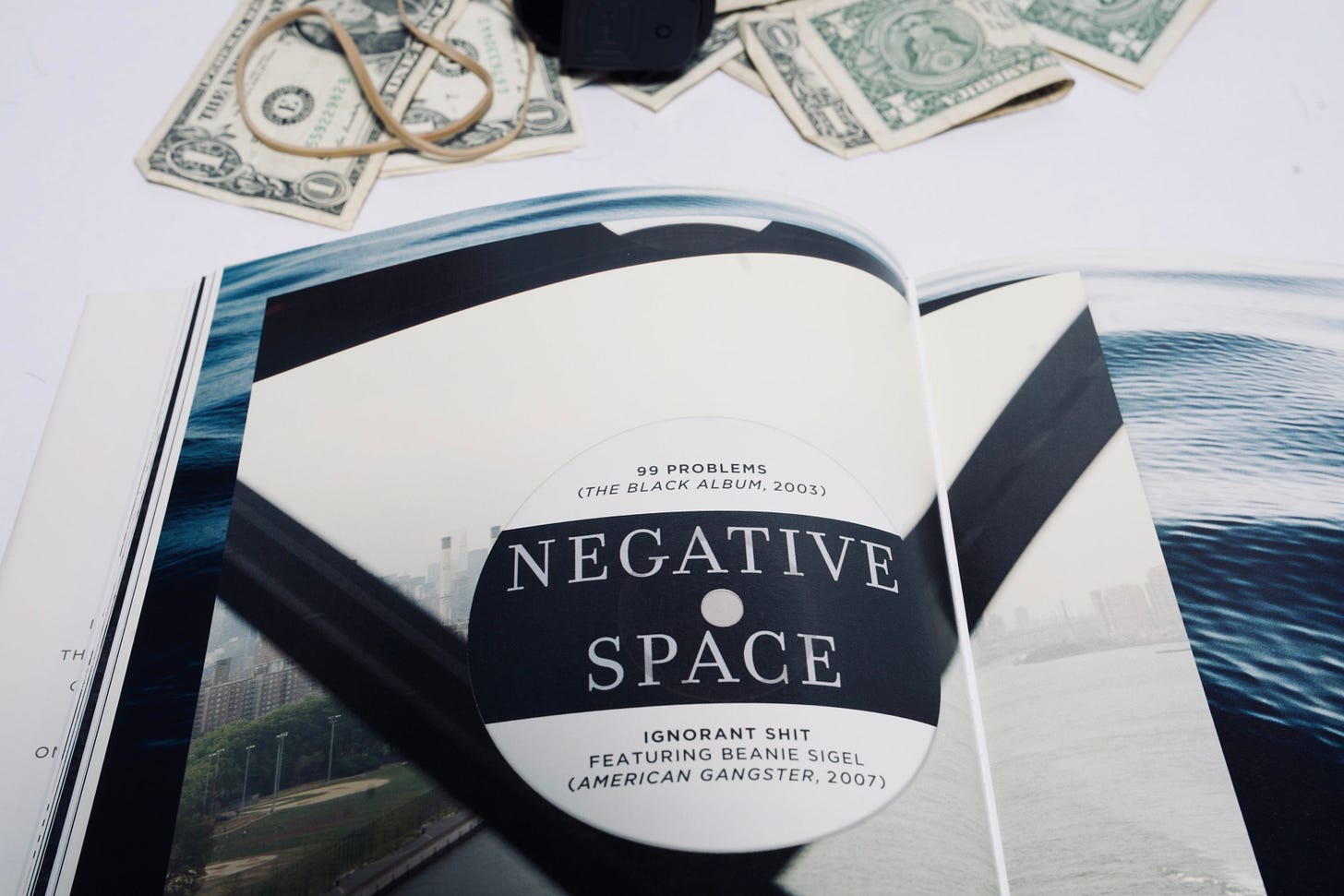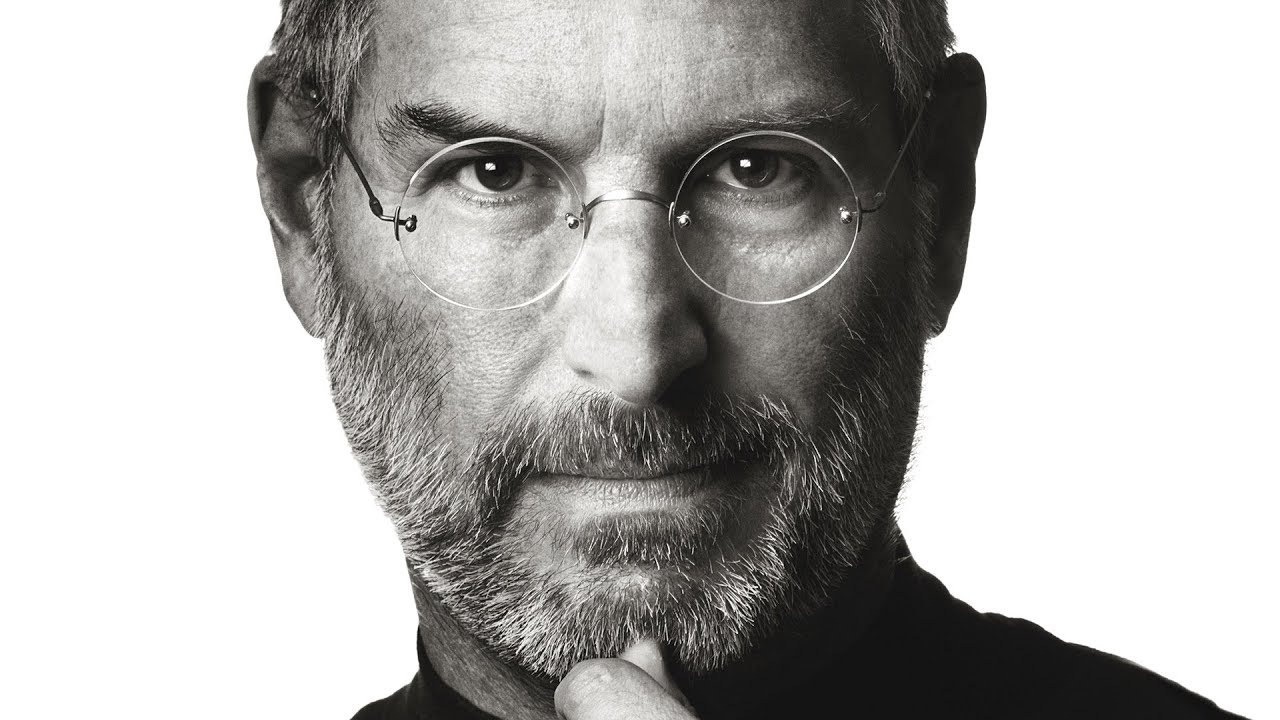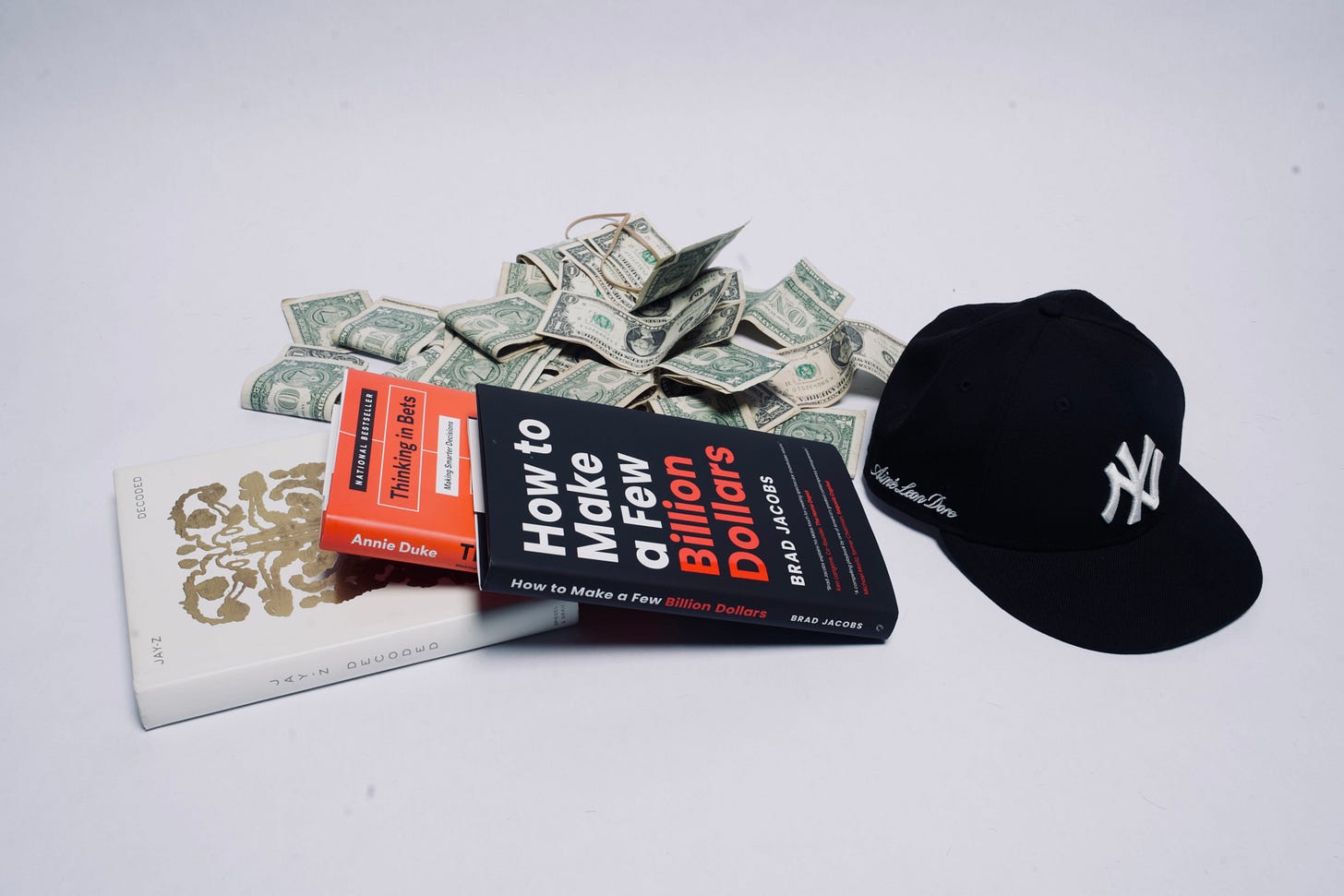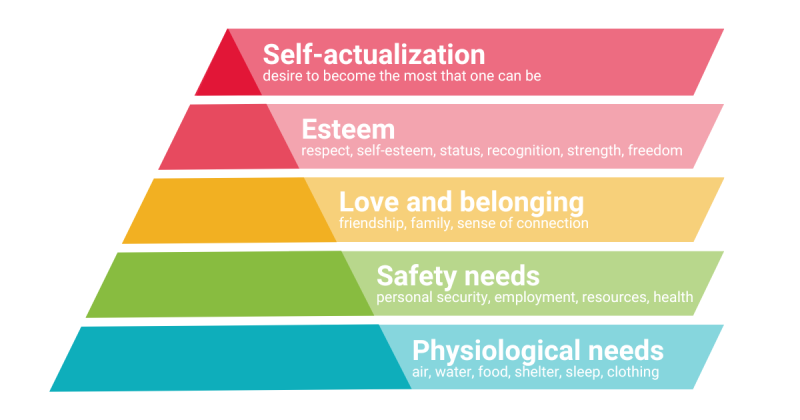99 Problems
The first quarter of the year ends today March 31st. With that 25% of 2025 is over and for the remainder of the year I want more problems. I’m at a stage in my life where the only games I want to play are the ones related to wealth creation—solving problems prolifically is a requirement to that. The best problems present as paradoxes; at first glance they may seem unsolvable, but in reality, they aren’t impossible to overcome when approached correctly. It’s easy to tell yourself that you’ll face the problems in your life, but in practice, it’s actually a very hard thing to do consistently. But that’s just a problem too, and like any other problem, can be identified, analyzed, and eventually game-planned against to be effectively solved.
We’re currently living through a period of big change in terms of information technology. Almost every month there’s a new breakthrough advancement in Artificial Intelligence—a tech that’s already impacting millions of people’s lives and will continue to do so over the years to come. At a macro level growth is inevitable; no matter what we do, it won’t stop. On an individual level, growth can only come from action. Put another way: we must solve our problems to get what we want out of life. No one should care more than you when it comes to desiring a better future for yourself. And nobody can force you to take the actions necessary to turn that desire into a reality. The road to self-actualization is an individual sport, like Track & Field.
If you look at some of the greatest minds in history you’ll find a common trait in them being world-class in their ability to not let problems get in the way of progress. You being here reading this means you’re likely in pursuit of that trait. I’m forsure in pursuit of it. Truthfully, the real move going forward is figuring out how to capitalize on all this macro change to facilitate the ideal realities that we envision for ourselves. “Problems” is about that. Below we’ll discuss four different areas of life where problems arise and how to best handle them on the journey toward self-excellence. We’ll reframe problems into what they actually are: growth opportunities. Intertwined, I’ll introduce tenets of a practical framework that I use to solve my problems—developed over years of trial & error, based off ideals I’ve learned from my different walks of life with a focus on: Computer Science, Finance, Psychology, Music, and Sports.
I don’t know what you take me as
Or understand the intelligence that JAY-Z has
I’m from rags to riches, niggas I ain’t dumb
I got ninety-nine problems, but a bitch ain’t one - hit me!
-JAY-Z
Mo Money, Mo Problems
(Money)
As an adult you make anywhere from 70 to 300 conscious decisions everyday on average. Can you guess how many of those are about or related to money? It probably varies from person to person, but I’d guess it’s somewhere around 20-40%, and thats being conservative. Money makes the world go round’, we covered that in my writing: Money. It’s the lifeblood of society. Some believe it being so important creates unnecessary problems, but without it a barrage of other issues would pop up in its absence. We all need money. And if we have to handle more problems in order to get more money, then so be it, “bring on the problems.”
They say mo money, mo problems
Bring on the problems…
Bring on the problems…-Drake
This brings us to the first, out of four, problem solving framework tenets…
tenet #1: what gets tracked, gets prioritized & what doesn’t get tracked, gets put off.
There were times in my life where I had a long-standing issue that I wanted to fix but put it off for a variety of reasons. In the past what would have to happen is the pain from the problem would have to get so great to the point where I couldn’t ignore it anymore and was forced to take action. I refuse to live like that now and have found that being proactive on addressing the issues in my life pays at a much higher annual percentage rate when it comes to growth.
Tip: Use a daily reminder to prompt yourself to take the next step towards fixing a long-standing issue. I use the Reminders app on the iPhone to set reminders and tell it to repeat daily. Seeing the call-to-action at the same time everyday is enough motivation to get me moving in the right direction. Most recently I did this to start working on my flexibility issues.
In his book, “The Psychology of Money,” Morgan Housel claims the highest form of wealth is having the ability to wake up and decide what you want to do each and everyday. I agree with him. We get one shot at life, and we should spend that in pursuit of things that are important to us. If you’re working in a career or doing a job that doesn’t connect with you spiritually or doesn’t feel like your life’s mission, that’s a problem. The amount of money required to accomplish Housel’s statement will depend on your personal situation, but keep in mind it’s not actually about making a lot of money just so you can piss off your life doing meaningless things. If you’re already on a path that feels correct to you but just haven’t reached the mountain-top yet, then stay locked-in. Feel free to skip the below section since it doesn’t pertain to you.
When it comes to solving the problem of increasing one’s income, the two best practical options are:
Learning a high-value skill that can be combined with other skills that’ll allow you to provide higher levels of value. In most marketplaces, more value = more income.
Investing in assets that passively earn you money (bonus points if they’re tax advantaged). The money won’t come overnight but it will 100% come, eventually. There’s literally a machine called the U.S stock market where you put money in and let it sit for years and it’ll give you more money back than you put in. The historical returns of the S&P 500 prove this.
Regarding the first point, it’ll be up to you to decide on what skill or skills best suit your lifestyle. Choose something you have a natural interest in. Thanks to the internet, most skills can be monetized, and social media can be used as a powerful distribution channel when leveraged in the right way. In all actuality, the sky really is the limit. To give you some ideas, below are a few areas that I think are great paths to invest in going into future with the upcoming A.I revolution in mind:
Digital creator
Technology: Engineer/Product Manager/A.I Tool Expert
Sales
Each one of these share a few key characteristics:
They don’t require you to go back to school, as long as you’re willing to put in the work and can self-learn effectively, you’ll eventually get to the point where you can start earning money without any additional accreditation.
They prioritize physical autonomy, allowing you to work from anywhere and or find a remote job (if you’re goal is to get employed)
They act as launchpads. Each one has the potential to give you the ability to synergistically apply it in ways thats strategic, allowing you to grow into other areas as your interests and life evolve.
I challenge you to spend the next 30 days thinking about a skill that you’d like to build upon with the intention to eventually monetize it. Additionally, I want you to invest $100 in a company that has a product that you believe in or use regularly. A second option is to invest $100 into crypto—if you’re unsure what to invest in crypto-wise, read: The Revolution Will Not Be Televised. You owe it to yourself to believe that you can learn the skills needed to improve your situation. This life is full of abundance, even if it’s not always easy to see. I’ve been on both sides of the table, and that’s why I can confidently tell you that it’s possible. I’ve worked with people who filled blank text files on a computer with computer code—writing that’s essentially just plain English assembled into logical pieces that, when executed together, form a program—A program that eventually sold for billions of dollars. I know because I had a hand in writing it. With A.I rapidly advancing, it’s never been easier to acquire the necessary skills needed to generate multiple streams of income. It’s ok to start off small and do things that don’t scale. Keep working, it’ll all make sense(cents) eventually.
Rap critics that say he's Money, Cash, Hoes
I'm from the hood stupid, what type of facts are those?
If you grew up with holes in your zapatos
You'd celebrate the minute you was havin' dough
-JAY-Z
The Good, The Bad, And The Ugly
(Health)
When it comes to technology brands its hard to find one more iconic than Apple. From humble beginnings in a garage in the Los Altos area of Silicon Valley, Apple has risen to become a juggernaut in the world of technology and business. For the majority of Apple’s nearly half-a-century existence, one man sat at the helm when it came to making the companies top-level decisions—Steve Jobs. Jobs’ genius was in his ability to predict the future and use every tool at his disposal to make reality line-up with what he envisioned. In the process of this, when it came to handling problems, it didn’t get much better than Jobs. His track-record speaks to that.
Earlier I implied that we should all want more problems in our lives if we want to bring forth desired growth, but I’d like to add a caveat to that statement. There is one category of problems that I don’t want, and I don’t wish on anyone, and those are problems related to health.
In the world of business, there weren’t many problems that Jobs couldn’t solve, and because of that his creation Apple quickly became a house-hold name. In the year 2025 it doesn’t get much more ubiquitous than an iPhone in terms of tech products in the developed world. By all accounts, Jobs life was on an amazing trajectory up until October of 2003, when he was diagnosed with a rare, highly fatal form of pancreatic cancer. In a popular graduation speech he gave at Stanford back in ‘05 he reflected back on how dire his doctor thought the situation was:
“My doctor advised me to go home and get my affairs in order, which is doctor's code for prepare to die.”
In 2004 Jobs underwent a Whipple procedure that was successful, giving him more time to live. Unfortunately, less than seven years later from the time he gave his highly inspirational speech to a stadium of Stanford graduates, Jobs’ cancer came back, this time spreading to his liver, In January of 2011 Jobs stepped down from his role as CEO at Apple for the final time to focus on his health. By then the cancer had turned terminal, Jobs succumbed to his illness shortly after in early October of 2011. Steve Jobs had access to the best doctors in the world, he was a billionaire and I’m sure if it was possible, he would of left no dollar spared in searching for a cure for his health problems. The unfortunate truth is at that time, there was nothing else that could’ve been done to save him. I have no desire to try to spin health problems into something positive, they aren’t and are best avoided.
tenet #2: acceptance is the seed of change; a problem must be accepted before it can be changed.
Ten years ago I had a healthy dose of health-anxiety. What started off as a routine yearly physical with a doctor who wanted to be very thorough, tripped off a spiral of negative thoughts inside of me that birthed a mild-case of hypochondria. In hindsight I can look back on my naiveness with humor and laugh, but in the now the feelings were anything but funny. I can now go and get regular check-ups and tests with not an ounce of fear. I actually enjoy going to the doctor now. Thinking back a key catalyst that solved this problem was an experience with anesthesia. I had a lot of unease around being “turned off like a tv,” thats how being put under was described to me at the time. I remember being pretty nervous on my way to the hospital that day, and I stayed nervous all the way up until a few minutes before I would take my propofol fueled nap. I can’t really recall exactly what it was but I remember just getting to the point of acceptance about the whole situation. Everything. As soon as I did all the fear evaporated. When I accepted the situation it felt like shackles had been removed from me, and truth be told I no longer could care enough to have any fears. I still remember watching the anesthesiologists thumb press down on the syringe filled with propofol, feeling a tingle in my face and then nothing. It was true, my tv really did get turned off. Luckily for me, a short while later it turned back on and I was on my way. That was it though, after that day I stopped having fear towards my health & death in general, some would call this exposure therapy.
The great thing about health is it doesn’t take a lot of fancy stuff be on the right track in terms of prevention of issues. In programming there’s a principle called K.I.S.S which stands for: Keep It Simple Stupid, when it comes to solving health problems this is the best path to follow. Health problems can be tricky and aren’t always in our control in terms of avoiding. The best approach here is to control the controllable, eat right, stay active and hit the gym 3-5 times per week, hit the sauna, and don’t forget cardio and mobility work. Get 7-8 hours of sleep per night. Take your vitamins and try to juice 1x a week bare minimum. These are just a few of the things that I do to maintain a baseline of good health.
And only thing that's gon' happen is I'ma get to clappin'
And he and his boys gonna be yappin' to the Captain
And there I go, trapped in the Kit-Kat again
Back through the system with the riff-raff again
-JAY-Z
Divide & Conquer Algorithms
(Relationships)
In Computer Science an algorithm is a series of steps to be followed that can predictably & verifiably solve a problem. At the core of all technology that we use everyday is an algorithm described in computer code on how to solve a particular problem. A Divide & Conquer style of algorithm is one where a top-level problem is repeatedly broken down, over and over, each time into a smaller subset problem until it can’t anymore, we call that un-dividable problem: the base case. From there each broken down problem is solved individually, because each one is small, solving it is easy. And here’s where the strength of this strategy shines: Given that the smaller problems came from a larger problem above it, solving all the small problems, that are way easier to solve, ultimately bubbles up and solves the larger problem that we started with. Some of the greatest algorithms that we depend on everyday to live our lives are based off this style of algorithm. Every time you search for something in Google, use GPS, or fire up Instagram to get your fix, divide & conquer algorithms are in the background doing work. This paradigm is so powerful that it can even be used socially, to help us deal with our relationship problems.
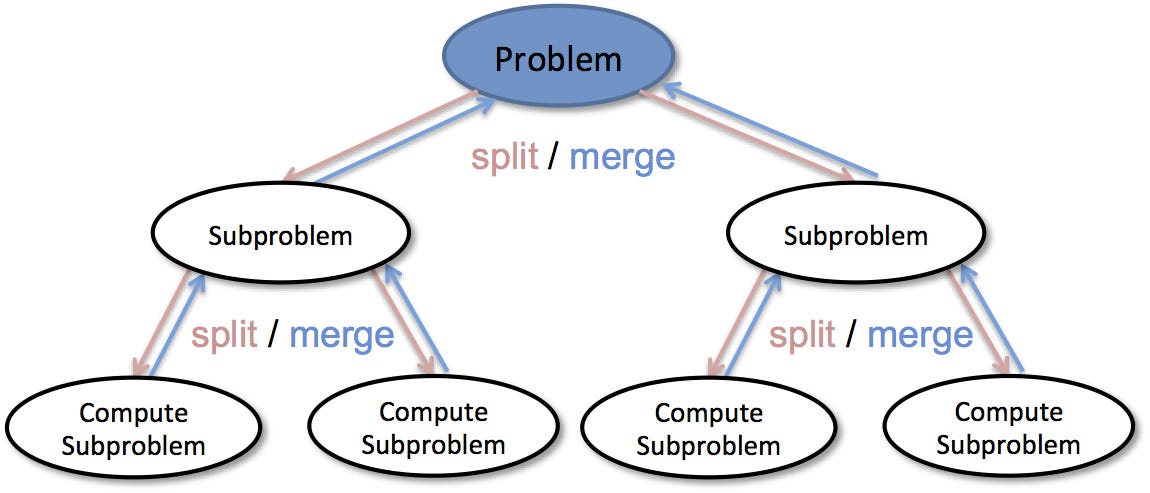
It’s well known as an adult it can be hard to meet the right people. Not only romantic, but platonic friends as well. As much as I value my alone time, I understand and accept my need for social relationships. We all need communion and a sense of belonging. The relationships that we foster and grow have the potential to control the trajectory of our lives both for the good and bad. Whether your desire is to find a romantic relationship or you’re looking for friends with whom you can develop deep authentic connections with, or maybe you’d like to just learn how to better navigate the sensitive & tricky dichotomy of interpersonal relationships in general. If we apply the divide & conquer paradigm to dealing with problems that arise out of our social interactions we can save ourselves a lot of time and energy. At the core what I’m suggesting in simplified words is to always stay curious in your social problems. Staying curious is how you’ll “break big problems down” into smaller ones. From there a smaller problem can be easier to reason about and ultimately reconcile. For example, applying it to the act of finding a partner, we arrive at a base-case of ourselves and the realization is: if you aren’t attracting the right type of person into your life then it might be because theres some aspect of you that still needs to be worked on before you’re ready for that type of connection. As talked about in Tribe, relationships should be entered into with a desire to give, not just receive. And they shouldn’t be looked at as a check-list item that needs to be done to live some interpretation of a “fulfilled life.”
When it comes to our relationships, it’s common to have problems and truthfully having problems in interpersonal relationships should be the status-quo. Let me point out that when I say problems I don’t mean arguments or constant toxic behavior. But we humans are complex, and to expect that when two or a group of us get together there won’t be any problems is willfully ignorant or extremely naive at best.
tenet #3: You’ll never know everything in any given situation; take the next logical step.
You have to accept that you’ll never truly know everything in any given situation. We all have different experiences which fuel our perspective. At best what we can do is stay curious of other perspectives and allow that to always fuel us to take the next logical step. Feel like someone misinterpreted you? Clear it up right away, don’t give things the time to fester and grow. The next logical step is often the most simple step you can take towards solving the issue at hand. It’s easy to brush it off as not important, especially if you can’t envision the full resolution, but don’t do that. Just like in the divide & conquer algorithm, the final solution may not become apparent until all of the smaller, derivative problems are solved. Only then will you have the perspective to solve the top-level problem.
D.A tried to give a nigga shaft again
Half a mil’ for bail cause I’m African
Tryna’ play the boy like he’s saccharine
But ain’t nothin’ sweet ‘bout how I hold my gun
I got 99 problems, bein’ a bitch ain’t one - hit me!
-JAY-Z
The Pain-Pleasure Principle
(Self)
human beings will do more to avoid pain than they will to gain pleasure.
The pain-pleasure principle came to me in my life when I was in enormous amounts of pain. Not a physical pain, although at times it felt like it was, but a more nascent, emotional type of pain, the one that feels like it just sits on you and burns—slowly. Pain can be an incredible energy source and becoming acquainted with it is ticket to adulthood for sure. But really, pain is even more than just that. Pain may be one of the best motivators when it comes to solving the problems in your life.
Maslow’s Hierarchy of needs is a theory on motivation pioneered by Abraham Maslow. It’s usually depicted visually as a pyramid, starting from the bottom there are five categories of needs important for human survival.
Go without any one of these or be lacking in any particular category and you’re sure to feel some form of latent pain. It’s natural. In that vein though, what is the pain attempting to communicate to us? A desire for growth, I’m sure you can see where I’m going next. The pain that you feel is really just the surface-level of a problem thats needing to be solved. A lot of people fear pain and, like the pain-pleasure principle do everything in their control to avoid it. Not knowing that by doing so, they’re actually causing even more pain for themselves. If you can reframe pain to be something that you actually seek instead of avoid, you’ll be on your way to unlocking a lot of your problem solving potential.
tenet #4: Never quit; no matter how many times you fail, keep trying.
Throughout all 4 years of high school I was a student athlete, my sport was Track & Field, and my events were the hurdles and the triple jump, often classified as two of the most physically demanding. During summer competition (we competed year round) we’d have to run the 400-meter hurdles, which is basically a one lap all-out sprint around the track with 10 hurdles placed in your path. The hurdles is the type of event where you learn to embrace pain both physically and mentally or eventually you quit. Each time you line up to run a 400 meter hurdle race you’re accepting the facts: you’re going to feel pain and you may fall. A statement that came true for me my sophomore year running in front of a crowd of thousands at a popular track meet at the University of Oregon. Coming off the curve my trail leg snagged a hurdle and put me onto the track so quick that I hadn’t even processed what was happening before I heard the crowd gasps in unison. I tumbled for a split-second and looked up to see my competitors leaving me in the dust, the possibility of winning the race was over for me at that point, but I still had to finish. I did what any solid hurdler would do, I got back up and finished the race to claps & encouragement of the crowd. Those 20 seconds of embarrassment seared into my psyche that day and taught me: In life things are going to go wrong and you’re going to look bad at times, who cares, get up every time and finish the task at hand and become better for next time.
If you made it this far I’m proud of you, I can also tell you’re ready to put in the work to solve more problems and continue to grow in the areas of your life that are important to you. I challenge you to identify 3 problems in any one of the categories we talked about today and for the rest of the year, actively work towards solving them. That’s where your growth for the rest of 2025 and beyond is. I started this writing by saying I want more problems(the good kind) and I’ll end with saying: I want more problems for you as well. Bring on the problems.
Images provided courtesy of Jose Zepeda.
Images are available for high-quality print in 16x24 $100, inquire if interested.


